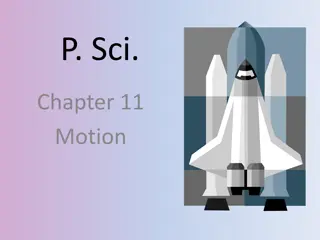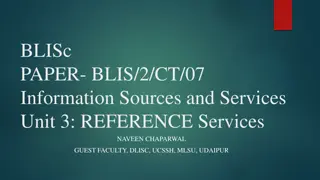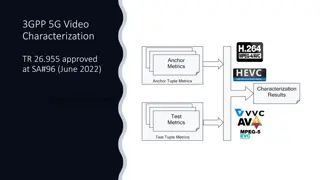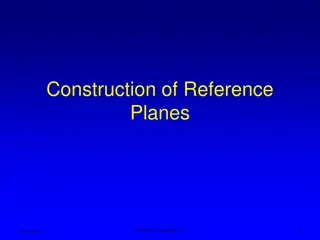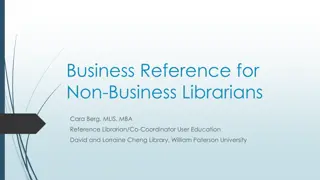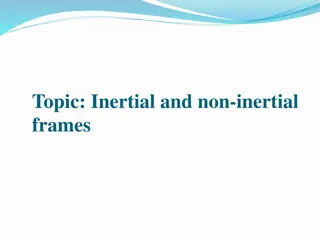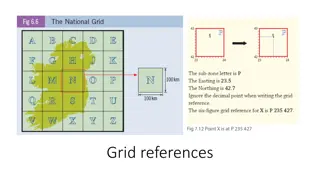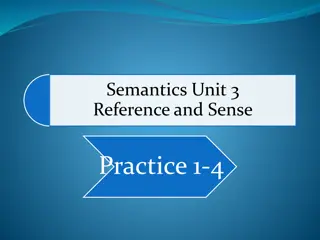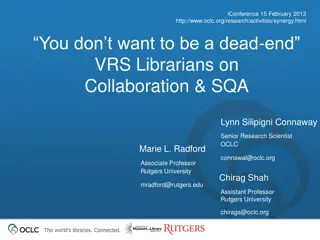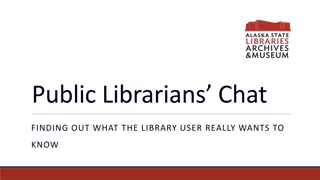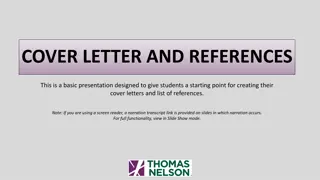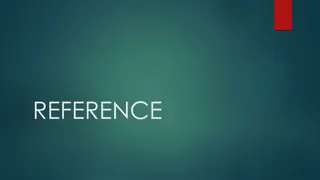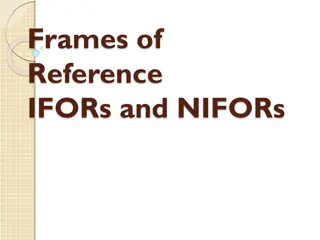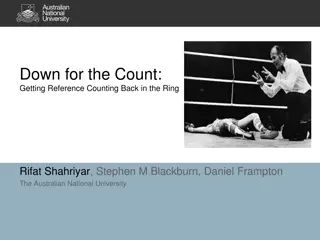
Mastering Academic Citations: Essential Style Guide Insights
Discover the key aspects of academic citation practices, including the importance of following style guides and maintaining consistency. Learn about different referencing styles, departmental guides, and common style guides like APA and Harvard. Enhance your skills in writing bibliographies effectively across various academic disciplines.
Download Presentation

Please find below an Image/Link to download the presentation.
The content on the website is provided AS IS for your information and personal use only. It may not be sold, licensed, or shared on other websites without obtaining consent from the author. If you encounter any issues during the download, it is possible that the publisher has removed the file from their server.
You are allowed to download the files provided on this website for personal or commercial use, subject to the condition that they are used lawfully. All files are the property of their respective owners.
The content on the website is provided AS IS for your information and personal use only. It may not be sold, licensed, or shared on other websites without obtaining consent from the author.
E N D
Presentation Transcript
+ Writing a bibliography and associated style guide features Essential Aspects of Academic Practice #4 John Morgan Student Learning Support Aberystwyth University jpm@aber.ac.uk
+Writing a bibliography #1 Bibliographies are absolutely essential and follow fixed patterns. There are many different styles of referencing and your department will advise on which style guide to use. If you study in more than one department it may be necessary to work with two or more style sheets. Even though this sounds demanding to follow, published writers do this all the time as different publishing companies and academic journals set their own styles that writers must follow.
+SgiliauAber / AberSkills Middle of the top right hand tabs in Blackboard https://www.aber.ac.uk/cy/aberskills/ (Cymraeg) https://www.aber.ac.uk/en/aberskills/ (English) Or go straight to Good Academic Practice and Referencing https://www.aber.ac.uk/en/aberskills/academic-practice/ (Cy.) https://www.aber.ac.uk/en/aberskills/academic-practice/ (En.) Look at Departmental Reference Guides
+Writing a bibliography #2 The guide included here is for books, chapters in edited books, journal articles and web sites, using an interpretation of the Harvard Referencing System. Harvard is not used in all departments, however, and even where it is recommended, you may see small variations in punctuation and layout. In some cases you will see variations that essentially merge different style guides, where guides are very similar, e.g. Harvard and APA. The most important factor when you have identified which style you are going to use is to be consistent.
+Common style guides: official or detailed guides APA: American Psychological Association http://www.apastyle.org Harvard (Detailed interpretation where main differences with APA can be seen) http://library.leeds.ac.uk/skills-referencing-harvard IEEE: Institute of Electrical and Electronics Engineers http://www.ieee.org/documents/ieeecitationref.pdf MHRA: Modern Humanities Research Association http://www.mhra.org.uk MLA: Modern Language Association https://www.mla.org
+Identify your style Identify the style guide that your department uses. If you cannot find it on the department s web-site or in its Blackboard pages, look on AberSkills, or ask a member of staff (in case of recent updates). If it is Harvard there is no official, definitive guide and universities all over the world have created their own summary guides that vary in small details like punctuation and layout of page numbers. Follow the exact recommendations of your department and note differences across departments. Academic and professional life demands that you are able to use multiple styles. Be consistent with all features.
+Same reference: different styles #1 APA Brumfit, C. & Johnson, K. (Eds.) (1979). The Communicative Approach to Language Teaching. Oxford: Oxford University Press. Harvard Brumfit, C. and Johnson, K. (Eds.). 1979. The Communicative Approach to Language Teaching. Oxford: Oxford University Press.
+Same reference: different styles #2 IEEE C. Brumfit & K. Johnson, Eds. The Communicative Approach to Language Teaching, Oxford: Oxford University Press, 1979.
+Same reference: different styles #3 MHRA Brumfit, Christopher, J. and Johnson, Keith, eds., The Communicative Approach to Language Teaching (Oxford: Oxford University Press, 1979) MLA Brumfit, Christopher, J. and Johnson, Keith, eds. The Communicative Approach to Language Teaching. Oxford: Oxford University Press, 1979.
+Harvard (one guide at AU) #1: Books Surname, initial/s. (Editor where appropriate). Date. Title of Book: And Subtitles where Appropriate (including 2nd or 3rd Edition, etc.). City of publication: Publisher s name. Brumfit, C. & Johnson, K. (Eds.). 1979. The Communicative Approach to Language Teaching. Oxford: Oxford University Press.
+Harvard (one guide at AU) #2: Chapters in edited books Surname, initial/s. Date. Title of Article: And Subtitles where Appropriate. In Surname, initial/s. (Editor where appropriate). Date. Hymes, D. 1971. On Communicative Competence. In Brumfit, C. & Johnson, K. (Eds.). 1979.
+Harvard (one guide at AU) #3: Journal articles Surname, initials. Date. Title of Article: And Subtitles where Appropriate. Journal Title Volume/edition: page numbers. Sheldon, L.E. 1998. Evaluating ELT Textbooks and Materials. ELT Journal 42/4: 237-46.
+Harvard (one guide at AU) #4: Internet: web sites Surname, initials. Date. Title of article: And Subtitles where Appropriate. [Available on-line]. URL (date accessed). Morkes, J. & Nielsen, J. 1997. Concise, SCANNABLE and Objective: How to Write for the Web. [Available on-line]. http://www.nngroup.com/articles/concise-scannable-and- objective-how-to-write-for-the-web (accessed 9/4/2015).
+Harvard (one guide at AU) #4: Internet and published source Many Internet resources do not indicate a specific author, especially if the source is a government document or some other public information report or organisational guidelines, etc. The next example uses such a reference, where the organisation acts as the author s name. Centers for Disease Control and Prevention. 1997. Take Charge of your Diabetes (2nd Edition). Atlanta: U.S. Department of Health and Human Services. [Available on-line]. http://www.cdc.gov/nccdphp/ddt/ddthome (accessed 1/1/2000).
+Important note Check with your department to identify the specific style guide that it requires students to use. The example in this document is one interpretation of Harvard. Other departments may recommend variations in layout and punctuation to these examples or may recommend external reference sources. Also consult departmental guides for uses of document types not listed here. This does not represent a definitive guide to referencing in all departments at Aberystwyth University and is presented here as an example.
+References #1 Arnaudet, M.L. and Barrett, M.E. 1984. Approaches to Academic Reading and Writing. Englewood Cliffs, N.J.: Prentice Hall Regents. In Jordan, R.R. 1997. Brumfit, C. & Johnson, K. (Eds.). 1979. The Communicative Approach to Language Teaching. Oxford: Oxford University Press. Campbell, C. 1990. Writing With Others Words: Using Background Reading Text in Academic Compositions. In Kroll, B. (Ed.) 1990. Second Language Writing. Cambridge: Cambridge University Press. In Jordan, R.R. 1997. Chomsky, N. 1965. Aspects of the Theory of Syntax. Cambridge: M.I.T. Press. In Hymes, D. 1971. Edge, J. 1983. Reading to Take Notes and to Summarise: A Classroom Procedure. Reading in a Foreign Language 1/2. In Jordan, R.R. 1997.
+References #2 Hymes, D. 1971. On Communicative Competence. In Brumfit, C. & Johnson, K. (Eds.). 1979. Johns, A.M. 1988. Reading for Summarising: An Approach to Text Orientation and Processing. Reading in a Foreign Language 4/2. In Jordan, R.R. 1997. Jordan, R.R. 1997. English for Academic Purposes: A Guide and Resource Book for Teachers. Cambridge: Cambridge University Press. Kroll, B. (Ed.). 1990. Second Language Writing. Cambridge: Cambridge University Press. In Jordan, R.R. 1997. Leki, I. and Carson J. 1994. Students Perceptions of EAP Writing Instruction and Writing Needs across the Disciplines. TESOL Quarterly28/1. In Jordan, R.R. 1997.
+References #3 Levinson, S. 1983. Pragmatics. Cambridge: Cambridge University Press. Morris, C.W. 1938. Foundations of the Theory of Signs in Levinson, S. 1983. National School Boards Foundation. 2000. Safe and Smart: Research and Guidelines for Children s User of the Internet [Available on- line] http://web.archive.org/web/20000510070615/http://www.nsbf.org/ safe-smart/full-report.htm (Accessed 8/4/15). Swales, J.M. and Feak, C.B. 1994. Academic Writing for Graduate Students. Ann Arbor: University of Michigan Press. In Jordan, R.R. 1997. Trzeciak, J. and Mackay, S.E. 1994. Study Skills for Academic Writing. Hemel Hempstead: Phoenix ELT. In Jordan, R.R. 1997.

